| 25 October |
• yesterday • tomorrow |
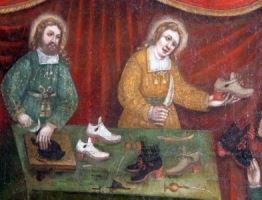
Crispinus and Crispianus
Brothers and members of the imperial Roman nobility. Together they evangelized Gaul in the middle 3rd century. They worked from Soissons, France where they preached in the streets by day, made shoes by night. Their charity, piety, and contempt of material things impressed the locals, and many converted in the years of their ministry. Martyred under emperor Maximian Herculeus, being tried by Rictus Varus, governor of Belgic Gaul and an enemy of Christianity. A great church was built at Soissons in the 6th century in their honor; Saint Eligius ornamented their shrine.
Because of his association with shoes, shoe-making, etc. a shoeshine kit is called a "Saint-Crispin"; an awl is "Saint Crispin's lance"; and if your shoes are too tight, you are "in Saint Crispin's prison."
tortured and beheaded c.286 at Rome, Italy
• cobblers, shoemakers
• glove makers
• lace makers, lace workers
• leather workers
• saddle makers, saddlers
• tanners
• weavers
• cobbler's last
• leather awl
• shoe
From the example of the saints it appears how foolish the pretenses of many Christians are, who imagine the care of a family, the business of a farm or a shop, the attention which they are obliged to give to their worldly profession, are impediments which excuse them from aiming at perfection. Such, indeed, they make them; but this is altogether owing to their own sloth and malice. How many saints have made these very employments the means of their perfection! Saint Paul made tents; Saints Crispin and Crispinian were shoemakers; the Blessed Virgin was taken up in the care of her poor cottage; Christ himself worked with his reputed father, and those saints who renounced all commerce with the world to devote themselves totally to the contemplation of heavenly things, made mats, tilled the earth, or copied and bound good books. The secret of the art of their sanctification was, that fulfilling the maxims of Christ, they studied to subdue their passions and die to themselves; they, with much earnestness and application, obtained of God, and improved daily in their souls, a spirit of devotion and prayer; their temporal business they regarded as a duty which they owed to God, and sanctified it by a pure and perfect intention, as Christ on earth directed every thing he did to the glory of his Father. In these very employments, they were careful to improve themselves in humility, meekness, resignation, divine charity, and all other virtues, by the occasion which call them forth at every moment, and in every action. Opportunities of every virtue, and every kind of good work never fail in all circumstances; and the chief means of our sanctification may be practiced in every state of life, which are self-denial and assiduous prayer, frequent aspirations, and pious meditation or reflections on spiritual truths, which disengage the affections from earthly things, and deeply imprint in the heart those of piety and religion. - by Father Alban Butler
https://catholicsaints.info/saint-crispin/
https://catholicsaints.info/saint-crispian/
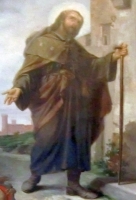
• Tadhg MacCarthy
• Taddeo Machar
• White Martyr of Münster
Son of the Lord of Muskerry, Ireland; grandson of the Lord of Kerry, Ireland. Educated by the Franciscans at Timoleague,at the University of Paris, and in Rome, Italy. Priest. Bishop of Ross, Ireland in 1482; when he arrived in Ross he found that Bishop Hugh O'Driscoll was still alive and holding the see. Because of the political intrigues of the time, and the fact that people were not above falsley reporting the bishop's death or sending an imposter to take his place, years of disputes broke out over the appointment, and Thaddeus never did assume his position. At one point he was excommunicated by Pope Sixtus IV, had the excommunication confirmed by Pope Innocent VIII, and charged with fraud; he was cleared of all charges, civil and ecclesiastic, and the excommunition revoked.
Bishop of Cork and Cloyne, Ireland on 21 April 1490. When he arrived he found that locals had chosen Gerald FitzGerald as bishop, and for political reasons there were armed supporters in the cathedral to prevent Thaddeus from assuming control. Thaddeus appealed to the Pope, and had his support, but without armed supporters he travelled for a while as a pilgrim to holy sites. He died while on the road. The title White Martyr of Munster commemorates the mental and physical anguish he suffered while trying to do the Church's work.
c.1455 in County Cork, Ireland
• 25 October 1492 in a pilgrim's hostel at Ivrea, Italy of natural causes
• the hostel warden found him deceased but surrounded by light
• Bishop Nicholas Garigliatti had a dream of Thaddeus's death and ascension to heaven, and came to collect the body, which would have otherwise been given a pauper's burial as the man was an unknown pilgrim
• buried in the cathedral of Ivrea
• miracles reported at the tomb
• body found incorrupt when the tomb was opened in 1742, but later deteriorated
• some relics enshrined in the Cathedral of Saint Mary and Saint Anne in Cork, Ireland
• some relics enshrined in the Cathedral of Saint Colman, Cobh, Ireland
• some relics enshrined in the Church of Saint Mary, Youghal, Ireland
1896 by Pope Leo XIII (cultus confirmation)
https://catholicsaints.info/blessed-thaddeus-mccarthy/
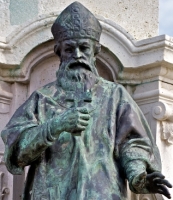
• Maurus of Nitra
• Maurus of Pannonhalma
• Maurice, Mauricio, Mauro, Mór
4 December (Benedictines)
Benedictine monk in his youth at the San Martin monastery in Pannonhalma, Hungary. Abbot his monastery from 1029 till 1036, having been chosen by Saint Stephen of Hungary. Friend of Saint Emeric of Hungary. Bishop of Pécs, Hungary in 1036, the second bishop of the diocese, and possibly the first bishop born in the kingdom of Hungary; he served for over 30 years. Finished construction of the cathedral in Pécs. Survived the pagan uprising during the reign of King Peter I, and helped celebrate the coronation of the Christian king Andrew I in 1046. Courtier to King Andrew. Helped found the Tihany Abbey in 1055. Peacemaker between warring political factions in Hungary. Wrote Legend of Saints Benedict and Andrew Zorard c.1064, making him the first Hungarian ecclesiastical writer and hagiographer.
c.1000, probably in the territory of modern Hungary
c.1075 in Pécs, Hungary of natural causes
22 July 1848 by Pope Pius IX (cultus confirmation)
Diocese of Pécs, Hungary
https://catholicsaints.info/blessed-maurus-of-pecs/
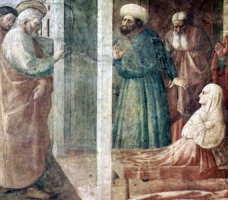
Dorcas
Married lay woman in Joppa (in modern Israel). Seamstress. Widow. Mentioned in the Acts of the Apostles. When she fell ill and died, she was raised from the dead by Saint Peter the Apostle.
1st century
Now in Joppa there was a disciple named Tabitha (which translated means Dorcas). She was completely occupied with good deeds and almsgiving. Now during those days she fell sick and died, so after washing her, they laid [her] out in a room upstairs. Since Lydda was near Joppa, the disciples, hearing that Peter was there, sent two men to him with the request, "Please come to us without delay." So Peter got up and went with them. When he arrived, they took him to the room upstairs where all the widows came to him weeping and showing him the tunics and cloaks that Dorcas had made while she was with them. Peter sent them all out and knelt down and prayed. Then he turned to her body and said, "Tabitha, rise up." She opened her eyes, saw Peter, and sat up. He gave her his hand and raised her up, and when he had called the holy ones and the widows, he presented her alive. This became known all over Joppa, and many came to believe in the Lord. - Acts 9:36-42
https://catholicsaints.info/saint-tabitha/
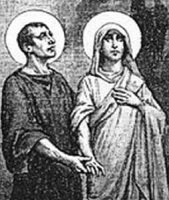
Crisaunt, Crescentius, Crisanto
Married couple who were zealous and public in their Christianity. Martyred in the persecutions of Numerian and Carinus.
Not surprisingly, many legends developed around a couple of married martyrs, and others were re-written to use them as their lead characters. Modern scholarship has dismissed all these, leaving only two of the thousands of faithful who lost their lives in the early days of the Church.
Egyptian
• stoned to death c.283 in a sandpit off the Salarian Way, Rome, Italy
• relics at Bad Münstereifel, Germany
• Eissel, Germany
• Salzburg, Austria
• ox skin
• sand pit
https://catholicsaints.info/saint-chrysanthus/
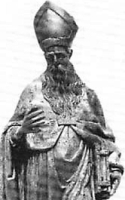
Gaudenty
Studied under Saint Philastrius, Bishop of Brescia, Italy. He preached throughout Italy and in the East, respected wherever he went for his oratory and leading the Christian life. When Philastrius died near the end of the 4th century, the people of Brescia chose Gaudentius as their bishop. He was consecrated by Saint Ambrose of Milan in 387. Guadentius wrote many pastoral letters, and ten of his sermons have come down to us. They show a desire to educate, and to present good examples for living.
He left his diocese in 405 to join a delegation sent by Pope Innocent I to defend Saint John Chrysostom from charges brought by a heretic. The group was forced by John's enemies to return to Italy. Their ship sank near Lampsacus, Greece, but the group finally safely reached home. Though the delegation did not achieve its mission, Saint John sent a letter of thanks to Saint Gaudentius.
at Brescia, Italy
410 of natural causes
https://catholicsaints.info/saint-gaudentius-of-brescia/
• Bernard of Calbo
• Bernard of Vich
• Bernard of Vic
• Bernat
Educated in Manso Calvo, Spain and Lleida, Spain. Benedictine Cistercian monk. Worked with Saint Raymond of Penyafort. Canon of the Tarragona cathedral and vicar-general in Tarragona, Spain. Appointed by Pope Gregory IX to combat the Waldenses in 1232 on the border of France. Bishop of Vich, Spain in 1233. Abbot of Santa Creus Monastery near Tarragona, Spain. Part of the of Council of Tarragona in 1239 and 1243.
1180 at Manso Calvo, Catalan, Spain
• 26 October 1243 in north Tarragona, Spain of natural causes
• interred in Vich, Spain
• some relics in the priory of San Pedro de Reus
https://catholicsaints.info/saint-bernard-of-calvo/

Minias
Soldier, though he is often depicted as a military prince. Evangelized among his fellow troops when stationed in Florence, Italy. Martyred in the persecutions of Decius. An abbey outside the Florence city walls is named for him.
c.250 in Florence, Italy
• young prince holding a crown
• young man crowned while holding a rod and palm
• young man crowned while holding a lily, rod and palm
• young man carrying his severed head
https://catholicsaints.info/saint-miniato-of-florence/
Hostiensis
Studied civil and canon law at Bologna, Italy. Taught in Bologna. Taught canon law in Paris, France. Diplomat from the court of King Henry III to Pope Innocent IV. Provost of of the diocese of Antibes, France. Chaplain to the pope. Bishop of Sisteron, France in 1244. Archbishop of Embrun, France in 1250. Cardinal-Bishop of Ostia and Velletri on 4 December 1261. Attended the conclave that elected Pope Gregory X, but his health prevented him from voting. Wrote a number of treaties on canon law.
Susa, Italy
25 October 1271 in Lyons, France of natural causes
https://catholicsaints.info/blessed-henry-of-segusio/
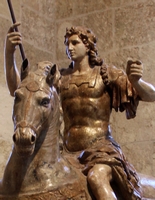
Gavino
Imperial Roman soldier executed for his faith in the persecutions of Diocletian. Martyr.
25 October 303 Porto Torres, Italy
in Italy: Camposano • Elini • Esporlatu • Gavoi • Illorai • Monti • Muros • Oniferi • Porto Torres • Sassari, archdiocese of • Sassari, city of
https://catholicsaints.info/saint-gavinus-of-sassari/

Front, Frontone, Frontón
Third-century missionary bishop of the Périgueux region of France.
Lycaonia, Asia Minor
• Périgueux, France of natural causes
• relics enshrined in Saint-Front cathedral in Périgueux
• relics thrown into the Dordogne river by Huguenots in 1575
https://catholicsaints.info/saint-fronto-of-perigueux/
Chély, Hilaire, Ilaro, Ilario
Adult convert. Hermit, living by the River Tarn. Monk at Lérins Abbey. Bishop of Mende, France. Miracle stories attached to him include being carried on the wind to a place of privacy for his prayers, and the ability to draw water from a dry well for years.
at Mende, southern France
• 535 of natural causes
• relics destroyed in 1793 in the looting of the French Revolution
https://catholicsaints.info/saint-hilary-of-mende/
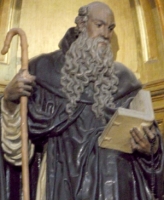
Fruitos, Frutos
Brother of Saint Engratia of Segovia and Saint Valentine of Segovia. When his brother and sister were martyred by invading Moors, Fructos fled and lived out his life as a hermit.
at Sepulveda, Castile (in modern Spain)
• c.715
• relics at Segovia, Spain
Segovia, Spain
https://catholicsaints.info/saint-fructos-of-segovia/
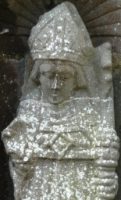
Gouéno, Gouenou, Gouesnou, Goueznou, Guennou
Brother of Saint Maughan. Emigrated to Brittany (part of modern France). Bishop of Léon, France.
at Cornwall, England
• 675 of natural causes
• most relics destroyed in the French Revolution
https://catholicsaints.info/saint-goeznoveus-of-leon/
Edmund MacDaniell
20 June as one of the Irish Martyrs
Jesuit seminarian. One of the Irish Martyrs. First Jesuit martyr in Europe.
Irish
hanged on 25 October 1572 in Cork, Ireland
27 September 1992 by Pope John Paul II in Rome, Italy
https://catholicsaints.info/blessed-edmund-daniel/

Gouernou, Goeznoveus, Governou, Guinou
Bishop of Quimper, Brittany. Founder of a monastery near Brest, France.
675 at Brest, France
https://catholicsaints.info/saint-guesnoveus/
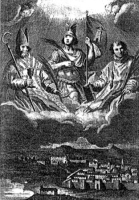
Deacon in Sardinia. Martyred in the persecutions of Diocletian.
beheaded in 303 in Porto Torres, Sardinia, Italy
https://catholicsaints.info/saint-januarius-of-sassari/

Priest in Sardinia. Martyred in the persecutions of Diocletian.
beheaded in 303 in Porto Torres, Sardinia, Italy
https://catholicsaints.info/saint-protus-of-sassari/
Doulchard
Monk at Saint-Mesmin Abbey in Orleans, France. Hermit near Bourges, France where the village of Saint-Doulchard was named for him.
584
https://catholicsaints.info/saint-dulcardus/
One of a group of 50 soldiers martyred together in the persecutions of Claudius II.
269 in Rome, Italy
https://catholicsaints.info/saint-lucius-of-rome-25-october/
One of a group of 50 soldiers martyred together in the persecutions of Claudius II.
269 in Rome, Italy
https://catholicsaints.info/saint-peter-of-rome-25-october/
One of a group of 50 soldiers martyred together in the persecutions of Claudius II.
269 in Rome, Italy
https://catholicsaints.info/saint-theodosius-of-rome/
Fifth-century bishop of Bayeux, France.
https://catholicsaints.info/saint-lupus-of-bayeux/
Sub-deacon. Martyred by Arians in the persecutions of emperor Constantius.
https://catholicsaints.info/saint-martirio-of-constantinople/
Cantor. Martyred by Arians in the persecutions of emperor Constantius.
https://catholicsaints.info/saint-marciano-of-constantinople/
One of a group of 50 soldiers martyred together in the persecutions of Claudius II.
269 in Rome, Italy
https://catholicsaints.info/saint-mark-of-rome/
Third-century missionary priest of the Périgueux region of France.
https://catholicsaints.info/saint-george-of-perigueux/
Martyred in the persecutions of Diocletian.
late 3rd century in Rome, Italy
https://catholicsaints.info/saint-cyrinus-of-rome/
Sixth-century bishop of Javols, France.
https://catholicsaints.info/saint-hilary-of-javols/
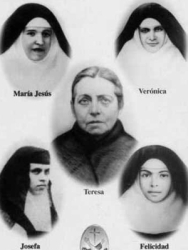
A mother, Blessed María Teresa Ferragud Roig de Masiá, and her four daughters, Blessed María Joaquina Masiá Ferragud, Blessed María Vicenta Masiá Ferragud, Blessed María Felicidad Masiá Ferragud and Blessed Josefa Ramona Masiá Ferragud, all nuns, who were Martyred in the Spanish Civil War.
25 October 1936 in Cruz Cubierta, Alzira, Valencia, Spain
11 March 2001 by Pope John Paul II
https://catholicsaints.info/martyrs-of-cruz-cubierta/
Following the dispute between the Pope and King Henry VIII in the 16th century, faith questions in the British Isles became entangled with political questions, with both often being settled by torture and murder of loyal Catholics. In 1970, the Vatican selected 40 martyrs, men and women, lay and religious, to represent the full group of perhaps 300 known to have died for their faith and allegiance to the Church between 1535 and 1679. They each have their own day of memorial, but are remembered as a group on 25 October.
•
25 October 1970 by Pope Paul VI
https://catholicsaints.info/forty-martyrs-of-england-and-wales/
A group of 46 soldiers and 21 civilians martyred together in the persecutions of Claudius II.
269 in Rome, Italy
https://catholicsaints.info/martyrs-of-rome-25-october/
Thousands of people were murdered in the anti-Catholic persecutions of the Spanish Civil War from 1934 to 1939. I have pages on each of them, but in most cases I have only found very minimal information. They are available on the CatholicSaints.Info site through these links:
• Blessed Alfons Arimany Ferrer
• Blessed Recaredo Centelles Abad
• Beneria
• Bernard of Saint Joseph
• Canna
• Catherine of Bosnia
• Cleto
• Daria of Connaught
• Derbilia of Connaught
• Dominic of Seville
• Ludovico of Arnstein
• Tegulo
CatholicSaints.Info Portable Edition